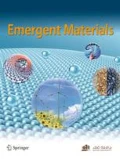The quest for new physical and chemical properties to discover new phenomena has given birth to low-dimensional (nD; n = 0, 1, and 2) nanomaterials. Two-dimensional (2D) materials are atomically thin layers with an electronic band structure different from their bulk (3D) counterparts and possess extraordinary electrical, magnetic, optical, mechanical, catalytic, and chemical properties. Top-down chemical or physical exfoliation and bottom-up chemical vapor deposition approaches are used to prepare 2D materials with crystal sizes ranging from as small as few micrometers to as large as wafer scales. Since the discovery of graphene in 2004, the family of 2D materials is ever expanding and now includes a diverse group of 2D materials in the list including 2D insulators such as hexagonal boron nitride (h-BN) and 2D semiconductors such as a family of transition metal dichalcogenides (TMDs) and monochalcogenides. What is more interesting is to combine these 2D materials to create engineered heterostructures for exploiting the cooperative advantage of different 2D layers. Such 2D materials can be interfaced with other 2D materials through the van der Waals weak forces and without any requirements of lattice matching. Such engineered van der Waals heterostructure has shown to unveil unique phenomena such as bandgap opening in graphene when placed on h-BN, unconventional superconductivity in twisted heterostructures of bilayer graphene, and unconventional ferroelectricity in twisted bilayer h-BN. Furthermore, mixed-dimensional van der Waals heterostructures (2D + nD; n = 0, 1, and 3) have revolutionized the application space as such as photovoltaic response in graphene-on-bulk semiconductor heterojunctions, field-effect transistor applications, and hybrid organic/inorganic heterostructures.
It is also important to understand that there are many challenges that still exist in the synthesis, design, characterization, and integration of 2D materials and heterostructures for advanced applications, which need to be addressed for 2D material-based technologies to make a transition from lab to market. The structural degradation of some atomically thin 2D layers in ambient conditions is a major impediment to their progress. High-quality films of 2D materials as well as their heterostructures are designed using micromechanical exfoliation of bulk crystals limiting the crystal size to few micrometers. The ability to grow high-quality, large-area, defect-free single crystals of 2D layers as well as in situ growth of controlled van der Waals heterostructures directly on desired dielectric/insulating substrates without using any transfer-related steps will revolutionize the area of 2D materials science and technology.
Considering the opportunities that come with the 2D materials and heterostructure devices and the associated challenges, a special issue is prepared in the journal of Emergent Materials entitled “Challenges and Opportunities for 2D Materials and their Heterostructure based Devices.” This special issue includes a total of 15 articles with 10 reviews and 5 original articles contributed from leading researchers across the globe. Emerging topics in the area of 2D materials and heterostructures such as moiré physics in 2D twisted van der Waals heterostructures, 2D magnetic materials, 2D ferroelectric materials, 2D perovskite materials, 2D transition metal dichalcogenides, 2D vanadium diselenide nanosheets, 2D indium selenide, heterostructures of 2D materials and quantum dots, photovoltaic solar cells based on 2D heterostructures, synthesis of lateral heterostructures, exciton–polariton condensates, metal–insulator transition, and graphene-insulator-graphene ReRAM technology are presented.
Each of the invited articles in this special issue is centered on highlighting the opportunities and addressing the challenges of emerging 2D nanomaterials and heterostructure-based devices. The editors believe that this special issue would aid the 2D materials research community to recognize the importance of the opportunities and challenges of 2D nanomaterials and heterostructure-based devices. There are many new structures, properties, and phenomena associated with 2D materials that are yet to be invented as well as new challenges to be overcome.
Acknowledgements
We would like to thank all the authors who contributed to this special issue. Finally, we would like to thank all the reviewers who generously provided their valuable time and expertise in reviewing the submitted manuscripts and giving feedbacks to the authors for improving the scientific quality.
Author information
Authors and Affiliations
Corresponding author
Ethics declarations
Disclaimer
The statements made herein are solely the responsibility of the editors.
Rights and permissions
About this article
Cite this article
Pradhan, N.R., Moon, B.H. & Behura, S.K. Preface on:“Challenges and Opportunities for 2D Materials and Heterostructure Devices”. emergent mater. 4, 811–812 (2021). https://doi.org/10.1007/s42247-021-00272-9
Published:
Issue Date:
DOI: https://doi.org/10.1007/s42247-021-00272-9

